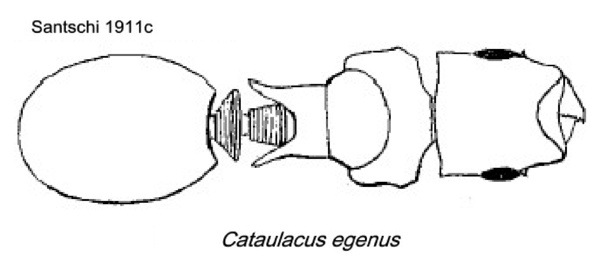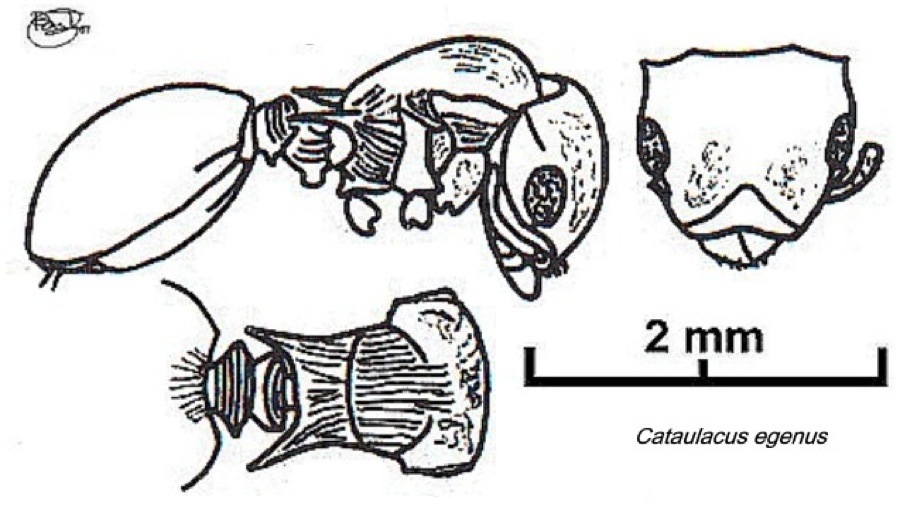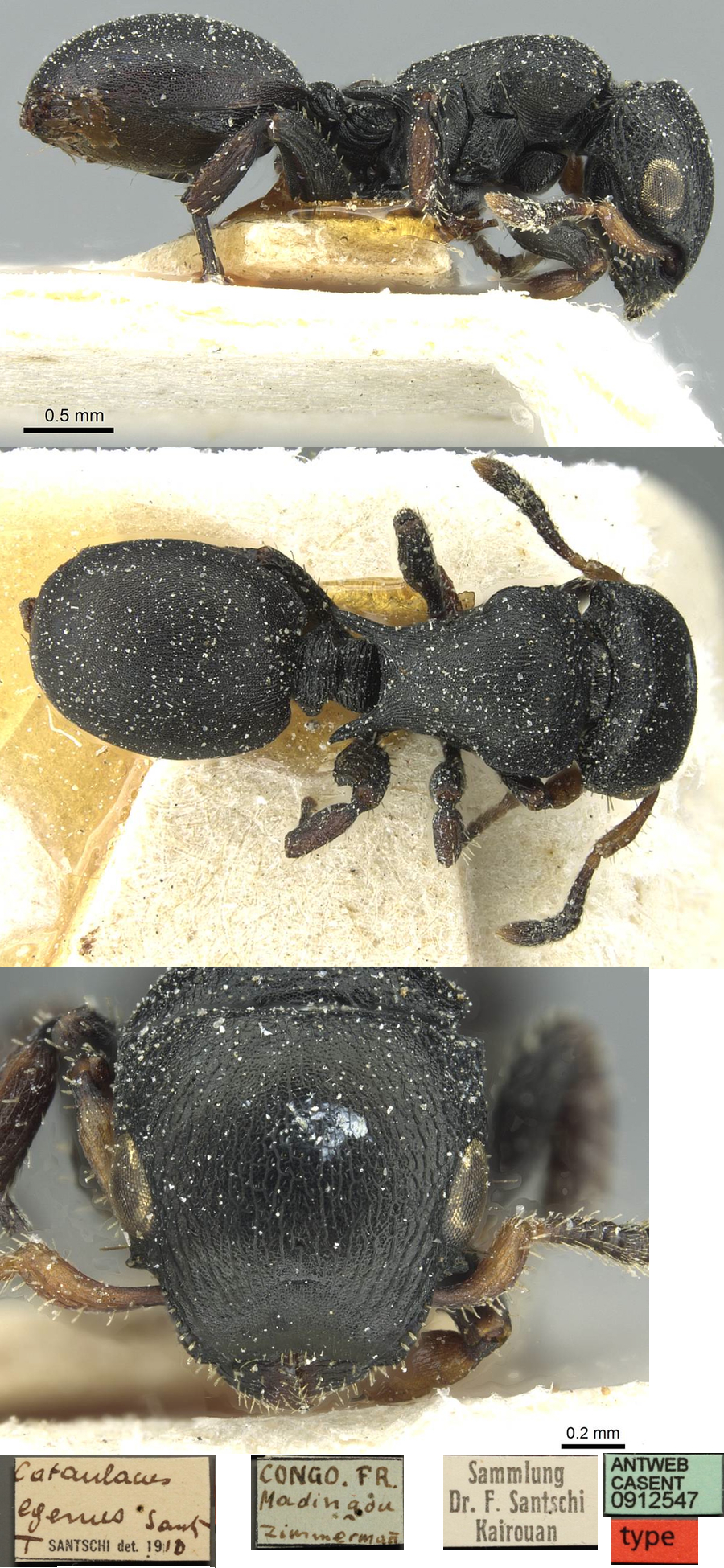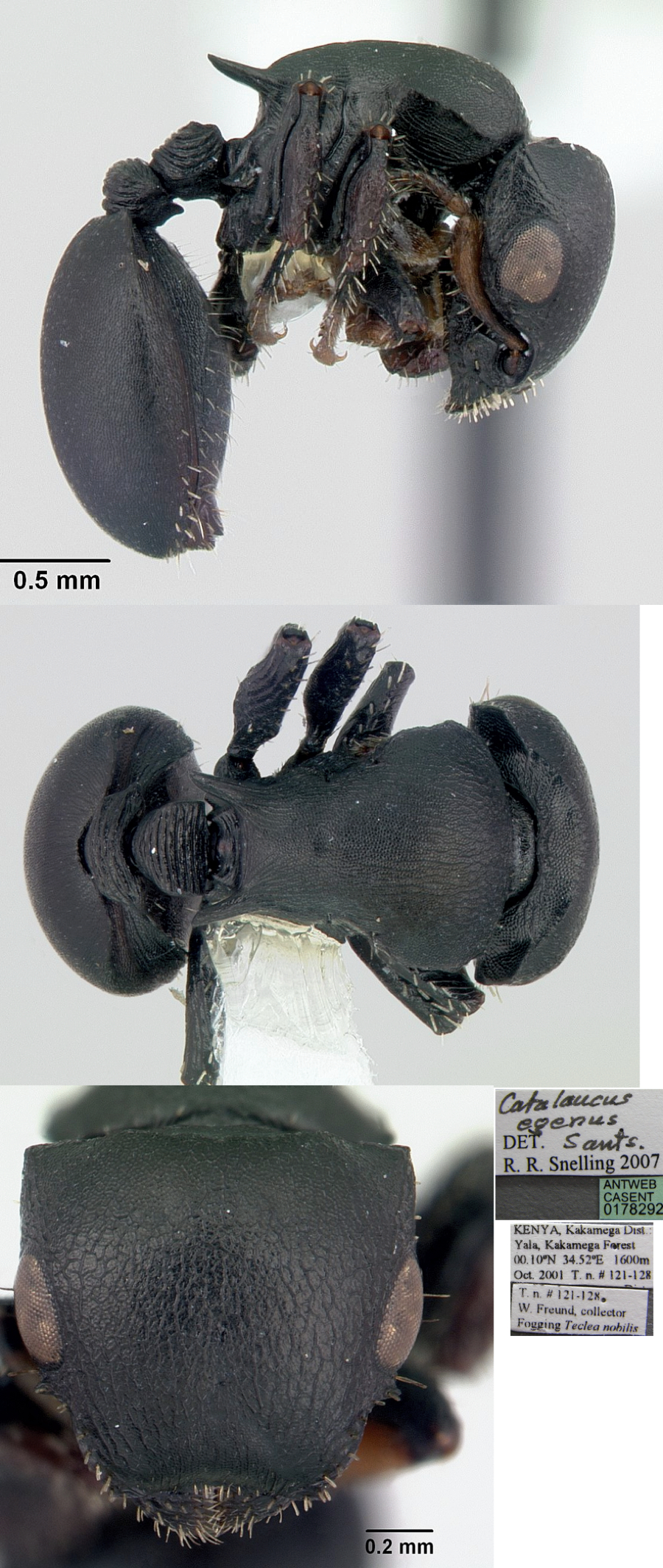Cataulacus egenus Santschi
  Type location Congo
(Cataulacus egenus n. sp.,
Santschi, 1911c: 359, illustrated, worker) collected at Madingon, by P.
Zimmermann - see below Type location Congo
(Cataulacus egenus n. sp.,
Santschi, 1911c: 359, illustrated, worker) collected at Madingon, by P.
Zimmermann - see below
junior synonym simplex (Cataulacus
egenus Santschi, stirps simplex
nov., Santschi, 1914b: 111,
illustrated, worker) from Uganda, central, C Alluaud, i.1909 - no images on Antweb (September 2014)
(see Bolton 1995)  . .
|
 Santschi's
(1911c) description is at Santschi's
(1911c) description is at  . Santschi's (1914b)
description of simplex
is at . Santschi's (1914b)
description of simplex
is at  . Bolton's modern
description (1974a), including male and queen, is at . Bolton's modern
description (1974a), including male and queen, is at 
Wheeler (1922: 199) noted the queen as TL 4.0-4.5 mm
(Bolton has TL 6.6-7.0 mm), very similar to the worker except in the
alitrunk structure; the mesonotum and sides of the pronotum are
longitudinally rugulose; the wings are whitish hyaline, with the
anterior border suffused with yellow, the wings pale yellow, the
pterostigma dark brown.
|
 Nigeria
specimens (Taylor, 1979: 11). WORKER. TL 4.2-6.1 mm, HL 1.10-1.48, HW
1.22-1.74, SL 0.62-0.80, PW 1.14-1.60
Nigeria
specimens (Taylor, 1979: 11). WORKER. TL 4.2-6.1 mm, HL 1.10-1.48, HW
1.22-1.74, SL 0.62-0.80, PW 1.14-1.60
The occipital crest is variously developed, but even when well
developed it is little more than an acute angle separating the vertex
from the occiput. The occipital corners have a dentiform angle or a
simple acute angle. The sculpturation of the head is finely
rugo-reticulate and the dorsum of the alitrunk is similar on the
pronotum but more obviously longitudinally rugose on the remainder.
There are no erect hairs on any dorsal surface. Similarly there are no
denticles on the head or alitrunk. The alitrunk is marginate only on
the pronotum, and has faintly marked sutures. The propodeal spines are
long and acute. The petiole and postpetiole are strongly transversely
rugose, with the postpetiole expanded laterally. The first gastral
tergite is marginate basally and antero-laterally, with a parallel
ridge on the sternite.
Uncommon in my Nigeria findings, they nest in
rotten branches on trees, including cocoa, foraging over the trunk and
leaves. I collected it also on low vegetation fringing the northern
edge of the Onipe block. Also collected at CRIN (B. Bolton) and at
Owena (J.T. Medler) (Bolton, 1974a: 18).
From Ghana, it was collected at Bunso (D.
Leston) and CRIG (D. Gibbs) (Bolton, 1974a). Later by Room (1971) (as Cataulacus
species G, defined by Bolton, 1974a) from cocoa mistletoe at the
Mamfe-Mampong cocoa farm, and listed from cocoa mistletoe by Room
(1975).
Bolton (1974a) also lists many findings from Zaïre.
|
 The
photomontage of the type worker is collated from http://www.antweb.org/specimen.do?name=casent0912547 The
photomontage of the type worker is collated from http://www.antweb.org/specimen.do?name=casent0912547
|
Oxford University Museum
specimens
Cataulacus egenus
B Taylor det.
male
|
Central African
Republic
P Annoyer
IN
|
14.x.2008
Dzanga-Sangha
03°03'58.3" N
16°08'59.6" E
|
528 m; Camp 1;
21h10-3h;
Sur plate-forme à 54 m du sol dans un Ayous (Triplochiton scleroxylon,
Sterculiaceae) à 50 m du camp
|
1
|
 |
|
 The
photomontage is of a male from the Central African Republic,
Dzanga-Sangha Nature Reserve; collector Philippe
Annoyer (CAR IN). The
photomontage is of a male from the Central African Republic,
Dzanga-Sangha Nature Reserve; collector Philippe
Annoyer (CAR IN).
This differs in some aspects from the Bolton (1974a)
description but the overall characteristics and size, with the
transversely sulcate petiole and postpetiole, appear to place it with egenus.
|
 The
photomontage of a specimen from Kenya, collated from http://www.antweb.org/specimen.do?name=casent0178292 The
photomontage of a specimen from Kenya, collated from http://www.antweb.org/specimen.do?name=casent0178292
|
|